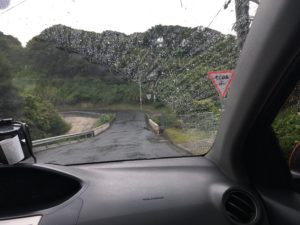
Visiting a Youth Prison: Costa Rican Exchange Part Two
This is part two of a multi-part series written by Landforce Executive Director Ilyssa Manspeizer about her reverse exchange with Costa Rican nonprofit Nueva Oportunidad. You can read part one here. Be on the lookout for more blog posts about the trip coming soon.
Monday, 15th July, 2019
 Today I visited a youth prison just outside of San Jose. It is reportedly one of the better youth prisons, and is a low-security facility with single-story detached cement blocks housing up to about 20 people each, interspersed by lovely shrub and flower-lined walks. There are cheerfully painted classrooms, an art room, an infirmary, and even a dentist’s office. People incarcerated there are given a wide range of privileges depending upon their behavior, their sentence, and the length of time they’ve been in jail. But make no mistake. There are about 100 people who are incarcerated there, ranging in age from 12 to 21. This is prison, and the conditions are grim.
Today I visited a youth prison just outside of San Jose. It is reportedly one of the better youth prisons, and is a low-security facility with single-story detached cement blocks housing up to about 20 people each, interspersed by lovely shrub and flower-lined walks. There are cheerfully painted classrooms, an art room, an infirmary, and even a dentist’s office. People incarcerated there are given a wide range of privileges depending upon their behavior, their sentence, and the length of time they’ve been in jail. But make no mistake. There are about 100 people who are incarcerated there, ranging in age from 12 to 21. This is prison, and the conditions are grim.
Bare concrete cells are often locked, with a shared, internal cement courtyard, covered by iron bars, and filled with graffiti (names, towns, and the occasional obscenity) and laundry set out to dry (everyone is responsible for hand washing their own). At lunch time we visited a unit where children (and yes, when you are between the ages of 12 and 18, you are a child) are held until their sentences are received. They were sitting at one of two large tables, eating their lunches (beans, rice, vegetables) out of brown plastic divided trays. Looking at them, some barely having started puberty, others, tall, but still with their baby faces, I couldn’t help but think of my 15 year old, who was likely, that very minute, sitting with her friends around a lunch table at summer camp. If, through some time and space warp we were able to transport these children to a beautiful camp along a New York river, you would never know which child was the prisoner, and which the camper. As I was pondering that, the smallest, and likely youngest, of the boys was called away to answer a telephone call from his Papa.
I do not write this to condemn the Costa Rican penal system. In fact, I suspect there are elements of justice the US system could learn here. I write this to record what I saw, and a little of what I felt, so that you can understand what came next. I was touring this prison with four of the staff of Foundacíon Nueva Oportunidad. They run soft skills trainings and micro-enterprise trainings with about 75 people a year throughout Costa Rica’s prison systems. They have been working in close collaboration with the prison administrators in this jail for nearly 6 years. As we left what seemed increasingly bleak units, with inmates with increasingly bleak prospects, we entered a zone where people had earned some privileges – to work (in landscaping & the kitchen) and earn up to $30 per month, to come and go from a prescribed area as they pleased, and to attend trainings offered by Nueva Oportunidad. As we approached these young adults (for they were all over 18 by this point), there seemed to be a real fondness flowing between them and the staff of Nueva Oportunidad – a comfort based upon shared experience, and a shared goal of successfully re-entering their communities.
I met one individual who had actually been released to a second prison (with a far worse reputation), where, trying to keep to himself and stay out of trouble, he was jumped by a group of inmates who had intended to kill him. He was returned to the first prison where Nueva Oportunidad, working with another nonprofit, had bought plant seeds, soil, pots, and other material, to teach a horticulture class. He discovered that he loved to grow the seeds, nurturing them until they were large enough to sell. Nueva Oportunidad does this on his behalf at local markets. He now puts away a portion of the profit to purchase future seeds, soils, and pots so that he can maintain a steady income. He already has a promise of a job lined up for when he is released from prison.
This was only the first of several prison visits, and I find myself simultaneously grieving for these children’s lost childhoods, and inspired by the adults who are helping create new opportunities for them to seize.
Ilyssa
Funding for the reverse exchange program has been provided by the U.S. Department of State’s Bureau of Educational and Cultural Affairs via Meridian International Center as the implementing partner

